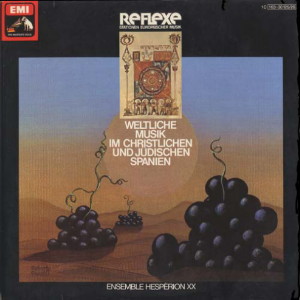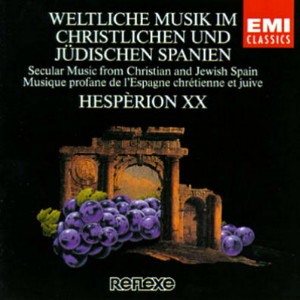 |
2 LP -
1C 163-30 125/26
|

|
| 2 CD - 7
63431 2 |
|
| Weltliche
Musik im Christlichen und Jüdischen
Spainen 1450-1550 |
|
|
|
|
|
Long Playing
1
|
|
|
| HOFMUSIK UND
FRAUENLIEDER im Zeitalter der
Entdecker (1492-1553) |
|
|
|
|
|
| "Villancicos"
aus "Cancionera de la Colombina" (Ende
des 15. Jahrh.) |
|
|
| - Niña y niña
(anonym) |
1' 35" |
|
| - Propiñán de
melyor (anonym) |
1' 41" |
|
| -
Como no la andaré yo?
(anonym) |
2' 19" |
|
| -
Recercada (anonym) |
1' 36" |
|
| -
Fantasia (Luys Milan; um 1500
- nach 1561) |
2' 15" |
|
| -
Pavana (Luys Milan; um 1500 -
nach 1561) |
1' 51" |
|
| "Villancicos" aus "Cancionera
de Palacio" (1490-1530) |
|
|
| -
Al alva venidi, buen amigo
(anonym) |
3' 45" |
|
| -
Perdi la mia rrueca (anonym) |
2' 21" |
|
| -
A los baños del amor (anonym) |
1' 33" |
|
| -
Fantasia (anonym) |
1' 38" |
|
| -
Romanesca (anonym) |
1' 13" |
|
| -
Pues bien para esta (Garcimunós) |
3' 19" |
|
| -
Si avéis dicho, marido
(anonym) |
1' 57" |
|
|
|
|
| - Si
d'amor pena sentis (anonym) |
5' 08" |
|
| - O voy
(Román)
|
1' 57" |
|
| - Qu' es de
ti, desconsolado (Juan del
Encina; 1468-1529) |
5' 29" |
|
| - Recercada 4
(Diego Ortiz; 1525-?) |
1' 41" |
|
- Recercada 5
(Diego Ortiz; 1525-?)
|
2' 20" |
|
- Recercada 6
(Diego Ortiz; 1525-?)
|
1' 14" |
|
| "Villancicos" aus "Cancionera
de Uppsala" (1500-1550) |
|
|
- Yo me soy la
morenica (anonym)
|
1' 11" |
|
- Si la noche
haze escura (anonym)
|
3' 45" |
|
- Soleta só jo
aci (anonym)
|
1' 31" |
|
- Con qué la
lavaré (anonym)
|
3' 50" |
|
- Soy
serranica (anonym)
|
1' 17" |
|
| Long Playing
2 |
|
|
| SEPHARDISCHE
ROMANZEN aus der Zeit vor der
Vertreibung der Juden aus Spanien
(1492) |
|
|
|
|
|
| -
Pregoneros van y vienen
(anonym) |
5' 06" |
|
| -
El rey de Francia tres hijas
tenia (anonym) |
5' 10" |
|
| -
Una matica de Ruda
(anonym) |
2' 48" |
|
| -
Palestina hermoza
(anonym) |
1' 30" |
|
| -
Nani, nani (anonym) |
6' 03" |
|
| -
El rey que tanto madruga
(anonym) |
3' 04" |
|
|
|
|
| -
Por qué llorax blanca niña
(anonym) |
7' 29" |
|
| -
Morcios los mis moricos
(anonym) |
2' 56" |
|
| -
Lavava y suspirava
(anonym) |
5' 33" |
|
| -
Paxarico tu te llamas
(anonym) |
1' 48" |
|
| -
La Reina xerifa mora
(anonym) |
5' 52" |
|
| -
Por alli pasó un cavallero
(anonym) |
3' 02" |
|
|
|
|
| ENSEMBLE HESPÈRION
XX |
|
| -
Montserrat Figueras, Sopran |
|
| -
Jordi Savall, Tenor- und
Baßgambe, Fidel und Chitarra
sarecenica (gestrichen) |
|
-
Hopkinson Smith, Renaissancelaute,
Laute und Chitarra saracenica
|
|
| -
Lorenzo Alpert, Flöte und
Schlaginstrumente |
|
| und |
|
| -
Arianne Maurette, Gambe |
|
| -
Pere Ros, Gambe |
|
| -
Gabriel Garrido, Schlaginstrumente |
|
| -
Pilar Figueras, Dudelsack |
|
|
|
|
|
Luogo
e data di registrazione |
|
Münstermuseum,
Basel (Svizzera) - novembre 1975 |
|
|
Registrazione: live /
studio |
|
studio |
|
|
Producer / Engineer |
|
Gerd
Berg / Johann Nikolaus Matthes
|
|
|
Prima Edizione LP |
|
EMI
Electrola "Reflexe" - 1C 163-30
125/26 - (2 lp) - durata 57' 18 /
51' 03" - (p) 1976 - Analogico |
|
|
Prima Edizione CD |
|
EMI
"Classics" - CDM 7 63431 2 - (2
cd) - durata 57' 18" / 51' 03" -
(c) 1991 - ADD |
|
|
Note |
|
- |
|
|
|
|
|
INTRODUZIONE
|
Court
Music and Villancicos
The song-book
called the Cancionero de
Palacio may have been
prepared at the royal court
of Ferdinand or at that of
the Duke of Alba. It belongs
to an important medieval
tradition: the attempt to
collect an entire repertory
either as a monument for
posterity or as an
expression of pride in the
repertory for its own sake.
Several hundred pieces are
unique to this source; many
composers are named only
here; and otherwise unknown
formal details give
important and interesting
information about the early
history of the tradition.
Not that it is the only
source for Spanish music at
the time; the earlier
manuscript at Seville and
the later ones at Segovia,
Elvas and Barcelona also
contain small selections of
the repertory. But from
those traces nobody could
have guessed the enormous
range and vitality of the
Spanish song tradition as
represented in the
Cancionero de Palacio.
Of the 450-odd surviving
pieces in the Cancionero de
Palacio, the great majority
are in villancico
form, a musico-poetic scheme
which is more condensed and
economic than any of the
other forms employed in
European art-song at the
time. Its main virtue
is its clarity, for the
simple contrast of refrain (estribillo)
and verse (mudanza)
allows of enormous
flexibility in the details.
Two other cancioneros included
here given even broader
scope to the variety of the
villancico. The
Cancionero de la Colombina
at Seville belonged to
Ferdinand Colombus, the son
of the explorer, and is the
earliest source for the
repertory; indeed, it is the
first known surviving
manuscript of Spanish
polyphony since the small Llibre
Vermell
of around 1400. The
Colombina manuscript shows
that French and Italien
polyphony were also known
there, but through all the
years the line of melody,
the passion and anguish of
the figurations and the
formal clarity retain their
identity.
The Cancionero de
Uppsala is so named
only because the single
surviving copy is in the
University library of that
city: the book was printed
at Venice in 1556 and its
contents are Spanish. The
curiously mixed collection
shows the development of the
villancico tradition
after the Cancionero de
Palacio: the musical
sections are longer here and
there is a proclivity for
four-part
writing (whereas the earlier
villancicos were
characteristically in three
parts), a move away from the
homophonic declamatory style
so favoured by Encina and
his contemporaries, and a
move towards a more
carefully wrought polyphony.
Con qué
la
lavaré? shows this
style at its best.
The other form heavilyy
represented in the
Cancionero de Palacio is the
romance: a long
narrative poem, or a section
of one, set to music in
simple four-line stanzas.
There is less purely formal
fascination here, of course,
for the music was devised
primarily with a view to the
clarest possible projection
of the text; but the long
historical tradition evident
behind such settings is one
of Spain's unique
contributions to our
understanding of medieval
Europe.
It was perhaps inevitable
that the romance
should have been heavily
embellished in performance,
as accounts of the time
describe: simple syllabic
melodies repeated many times
over homophonic chords
demand and even stimulate
resourceful musical and
mimetic invention on the
part of the performer.
Though such techniques were
not unique to Spain, it may
well have been because of
the strength of the romance
tradition that methodical
embellishment in written
musical sources seems to
have its roots in Spain.
The principles of
embellishment go far for the
dance patterns whose chordal
schemes imply no particular
melody: Mudarra’s
Romanesca is based on
a chord sequence that is
repeated three times with
different embellishments
around it; the three Ortiz recercadas
equally reflect a simple
chordal pattern with a
series of florid divisions
for viol.
From Notes
(c) David Fallows, 1976
Sephardic
Romances
It is no small
wonder that the Sephardim,
or Spanish-speaking Jews,
have continued to perpetuate
aspects of medieval Hispanic
culture up to the present
era, almost five centuries
after their expulsion from
Spain in 1492 and from
Portugal in 1506.
While historical sources
abound with testimonies of a
vibrant Jewish presence on
the Peninsula, there is
hardly any documentation
that attests to a purely
Jewish tradition of secular
music. Certainly the Jews,
apart from their sacred
liturgy, enjoyed a secular
heritage, which comprises a
rich and appropriate musical
repertoire to celebrate all
phases ofthe life cycle
(birth, childhood,
adolescence, courtship,
matrimony, death, etc) as
well as to commemorate the
sabbath and certain
religious holidays with
semi-liturgical song.
Recent scholarship has
concentrated upon the
Sephardic diaspora as a
laboratory for studying the
relics of the rich Iberian
past. In
studies dealing primarily
with the extant oral
tradition, much emphasis has
been given to the Romancero,
the corpus of Spanish
balladry: richly endowed
with archaic texts, some of
which date back to the 14th
century, the ballads employ
a great variety of tunes as
vehicles for their
performance.
From Issac Levy`s
four-volume collection
Chants judeó-espagnols
(London/Jerusalem, 1953-73),
HESPÈRION
XX have selected twelve
items of outstanding
musical, literary and
aesthetic interest. Their
aim has been to provide a
proper context for the
performance ofthe reflect
melodies and texts, one
which would coincide musical
practices before the
expulsion.
|
|
|
EMI Electrola
"Reflexe"
|
|
|
|

